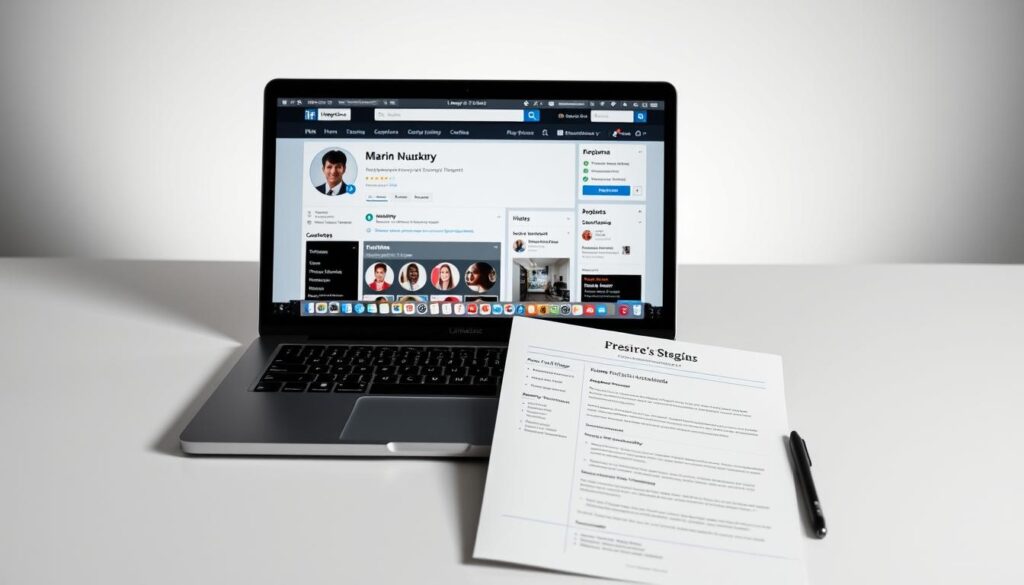What if your competition is landing roles faster while you’re still manually tweaking resumes? With 3 out of 4 professionals now using artificial intelligence in their career moves, traditional methods alone won’t cut it. The data speaks for itself: candidates leveraging smart solutions secure positions paying 61% more on average.
This isn’t about replacing human effort – it’s about amplifying it. Modern platforms like RoboApply analyze hiring patterns across 50+ industries, giving you real-time insights into what employers want. Imagine having a career coach that updates your application materials while you sleep, ensuring every submission matches current market demands.
You’ll learn to navigate platforms that handle repetitive tasks like resume formatting and interview scheduling. These systems don’t just save hours each week – they help you avoid the 83% of applications rejected by automated tracking systems before human eyes ever see them.
Key Takeaways
- AI users secure positions with 61% higher salaries than traditional applicants
- Automated tools prevent 83% of application rejections from resume scanners
- Real-time market analysis ensures your materials match employer needs
- Integrated systems handle scheduling and follow-ups automatically
- Customizable templates adapt to specific industries and roles
Understanding the Project Management Landscape
The demand for skilled professionals in organizational leadership has never been higher. Over the next decade, 22 million new positions will emerge globally across critical sectors. This surge creates a strategic window for career advancement if you know where to focus your efforts.
Industry Growth and Demand
Companies face a $208 billion productivity gap due to unfilled leadership roles. With a 33% increase in demand forecasted, now’s the time to position yourself in high-growth areas. Sectors like healthcare and energy need specialists who can navigate complex regulations while delivering results.
Key Sectors and Opportunities
Construction roles require expertise in safety protocols and supply chain coordination. In technology, focus shifts to agile methodologies for software launches and AI integration. Healthcare offers roles in streamlining patient care systems and managing telehealth expansions.
Prioritize industries with the most urgent hiring needs:
- Energy: Renewable projects need coordinators for grid modernization
- Finance: Digital payment systems demand risk management experts
- Transportation: Infrastructure upgrades require logistics planners
These fields reward certifications like PMP or Scrum Master credentials. Align your skills with sector-specific challenges to stand out in applications.
Leveraging AI to Streamline Your Job Search
Modern career advancement demands precision-tailored materials that speak directly to hiring teams. Artificial intelligence transforms how you present qualifications, turning generic documents into targeted career assets. Platforms like RoboApply decode employer preferences through pattern recognition across thousands of successful applications.

Smart Document Crafting
AI resume builders analyze your experience to create achievement-focused bullet points. Instead of listing duties, these systems highlight outcomes like “Reduced launch timelines by 40% through agile workflow redesign”. For cover letters, the technology drafts personalized content by cross-referencing job descriptions with your skills.
Beating Automated Screening
Over 70% of applications never reach human eyes due to tracking system filters. RoboApply’s scanner identifies missing keywords from postings and suggests strategic additions. Its grammar checker eliminates typos that trigger instant rejections – a critical step when 83% of hiring managers discard materials for minor errors.
Integrated solutions like those discussed in automated workflow platforms ensure your submissions align with current market expectations. You’ll maintain multiple resume versions for different roles while the AI continuously refines content based on real-time hiring trends.
Project Manager Job Search Tools
Your career toolkit needs precision instruments, not just basic utilities. Modern platforms transform scattered efforts into targeted campaigns, helping you outpace competitors who rely on outdated methods. Three critical capabilities separate effective solutions from time-wasting gadgets.
Essential Features to Look For
Prioritize systems offering real-time feedback loops. The best solutions analyze which resume versions earn interviews and which get ignored. Look for integrated trackers that map your progress across multiple opportunities while preventing duplicate submissions.
Automated follow-up systems prove vital – 62% of hiring teams say timely communication influences their decisions. Ensure your chosen platform optimizes materials for applicant tracking systems (ATS), as 74% of qualified candidates get filtered out by rigid algorithms.
How RoboApply Enhances Your Applications
RoboApply’s Chrome extension revolutionizes submission processes. It customizes each application while maintaining personal touches, adapting your leadership experience to specific role requirements. The system’s dashboard color-codes opportunities by priority and deadline, ensuring you never miss critical follow-ups.
Integrated CRM features track conversations with recruiters across email and LinkedIn. This creates a centralized hub for relationship-building – crucial when 85% of positions get filled through referrals. Pair these capabilities with streamlined solutions like JobRight for complete career campaign management.
Optimizing Your Resume and LinkedIn Profile

Your application materials need to work smarter, not harder. With 75% of hiring teams using automated screening tools, generic documents won’t get you noticed. The solution? Strategic alignment between your resume and online presence.
Tailoring Your Resume for ATS Success
Applicant tracking systems scan for exact matches to job descriptions. Use tools like RoboApply’s ATS optimizer to identify critical keywords. For example:
“Reduced software deployment costs by 28%” beats vague statements like “managed budgets.” Always quantify outcomes – numbers make your experience tangible to both robots and humans.
Formatting matters more than you think. Avoid graphics that confuse scanners. Stick to standard headings like “Professional Experience” instead of creative alternatives. Test your resume’s ATS compatibility using free online checkers before submitting.
Highlighting Key Achievements
Recruiters spend 7 seconds scanning your materials. Start bullet points with action verbs like “Spearheaded” or “Optimized.” Compare these approaches:
Weak: “Responsible for team coordination”
Strong: “Led 9-member cross-functional team to deliver mobile app 3 weeks ahead of schedule”
Your LinkedIn profile should echo these achievements using industry-specific terms. Include certifications in your headline – “PMP Certified Leader | Healthcare Systems Implementation” attracts more views. Update your skills section monthly to reflect trending requirements in your field.
Consistency between platforms builds credibility. Use matching job titles and timelines everywhere. Tools like RoboApply automatically sync your resume and profile updates, ensuring you present one unified professional story.
Automating Your Application Process
What if your applications could work while you focus on career growth? Modern solutions eliminate manual data entry without sacrificing personalization. RoboApply’s Chrome extension handles repetitive form-filling across platforms like LinkedIn and Indeed. It scans job descriptions to adjust your materials instantly, matching each role’s specific needs.
Smart Browser Tools Save Hours
The extension acts like a digital assistant, capturing company details and position requirements. It then rewrites your resume bullet points to emphasize relevant achievements. One user reported “saving 12 hours weekly” while applying to 40% more roles. You maintain control – review each customized application before submission.
Email Systems That Think Ahead
Connect your Gmail to career management platforms for intelligent follow-ups. Automated workflows send thank-you notes 24 hours after interviews and nudge silent recruiters after 10 days. Set triggers like:
- Reminders for upcoming deadlines
- Custom templates for different industries
- Status-based responses (e.g., rejection follow-ups)
These systems log every interaction, preventing duplicate messages. When a recruiter opens your email three times, the tool suggests sending additional portfolio samples. This strategic approach keeps you visible without overwhelming hiring teams.
Mastering Networking and Digital Profiles
Your next career breakthrough might come from someone you haven’t met yet. Professional networking triples interview opportunities compared to cold applications. Digital platforms now let you build relationships at scale while maintaining genuine interactions.

Building a Strong Online Presence
Expand beyond basic LinkedIn profiles. Join PMI chapters or Agile Alliance forums where hiring managers scout talent. Share case studies in industry groups – posts with “lessons learned” get 73% more engagement than generic content.
Update your profile weekly with trending keywords. Mention certifications in your headline and summarize achievements using metrics. Tools like RoboApply’s CRM track which updates generate profile views from target companies.
Effective Connection and Referral Strategies
Personalized outreach beats mass messaging. Reference a contact’s recent webinar or article before requesting a chat. Example: “Your insights on risk mitigation resonated – would love to discuss healthcare project challenges.”
Automate follow-ups without losing authenticity. Schedule quarterly check-ins using calendar integrations. Track referral sources through centralized dashboards, prioritizing advocates who’ve opened your messages multiple times.
Attend virtual summits with built-in networking features. Many events now offer AI matchmaking that connects you with decision-makers based on shared interests. Always send tailored thank-you notes within 24 hours of meetings.
Tracking Your Job Applications and Progress
Professionals using organized tracking systems report 50% higher response rates from employers. Without clear visibility into your application pipeline, critical follow-ups and deadlines easily get lost in the shuffle. Modern solutions turn chaotic spreadsheets into strategic dashboards that keep you in control.
Utilizing Job Tracker Tools
RoboApply’s system automatically logs every submission with timestamps and company details. You’ll see color-coded status updates – red for expired opportunities, green for upcoming interviews. This prevents duplicate applications to the same team, a common issue when using multiple job boards.
Effective organization starts with categorizing applications:
- Awaiting Response: Track silent submissions needing follow-up
- Interview Phase: Store preparation notes and schedule reminders
- Offer Negotiation: Compare compensation packages side-by-side
The platform’s analytics reveal patterns – maybe your optimized resume templates perform better in healthcare than tech. Set automatic alerts for approaching deadlines, ensuring you never miss a recruiter’s call.
Maintain relationship records within the tracker. Store hiring managers’ LinkedIn profiles and previous conversation history. When positions reopen, you’ll have existing contacts to re-engage – 68% of recruiters prefer candidates who demonstrate organized follow-through.
Preparing for Interviews with AI Coaching
Your final interview preparation requires more than rehearsed answers. Modern platforms analyze your unique communication style while simulating real hiring scenarios. These systems identify patterns recruiters notice – from speech cadence to strategic storytelling – giving you an edge competitors lack.
Practicing with Virtual Interview Tools
RoboApply’s simulation generates mock interviews based on actual job descriptions. You’ll face role-specific questions like “Describe a time you resolved cross-team conflicts under tight deadlines.” The AI adjusts difficulty as you improve, mimicking progressive interview rounds at top firms.
Leveraging Real-Time Feedback for Improvement
After each practice session, receive instant analysis of your pacing and word choice. The system might suggest: “Replace ‘I think’ with data-driven statements” or “Maintain eye contact during competency questions.” Video playback highlights nervous gestures like excessive hand movements.
Integrate these insights with career documentation examples for full alignment. Continuous practice sharpens your ability to articulate achievements concisely – a skill 89% of hiring managers prioritize. You’ll enter actual interviews calibrated to industry expectations, not generic advice.
FAQ
Which industries have the highest demand for project managers today?
Healthcare, tech, construction, and finance sectors are actively hiring due to digital transformation and infrastructure growth. Platforms like LinkedIn Jobs and Indeed show increased postings for roles in Agile software development, healthcare IT, and renewable energy projects.
How can AI tools like RoboApply speed up my job applications?
RoboApply automates filling out repetitive application fields, tailors resumes using ATS-friendly keywords, and submits customized cover letters. This reduces manual errors and ensures you meet employer-specific requirements efficiently.
What’s the best way to optimize my LinkedIn profile for recruiters?
Use industry-specific keywords (e.g., “Scrum Master,” “budget oversight”), showcase certifications like PMP or CAPM, and add quantifiable achievements. Enable LinkedIn’s “Open to Work” feature and engage with PM groups to boost visibility.
Can automation tools integrate with email platforms like Gmail?
Yes. Tools like Zapier connect job boards to your inbox, auto-save applications to spreadsheets, and trigger follow-up reminders. For example, set rules to forward Indeed alerts to a dedicated folder and track responses in Trello.
How do AI interview coaches prepare me for real hiring scenarios?
Platforms like InterviewBuddy simulate video interviews using common PM questions (e.g., “Describe a conflict resolution”). They analyze your tone, pacing, and content, then provide instant feedback to refine answers about timelines, stakeholder management, or risk mitigation.
What should I track in a job application spreadsheet?
Log company names, application dates, hiring manager contacts, and follow-up status. Tools like Huntr or Google Sheets templates help monitor response rates, interview stages, and feedback to identify patterns in your search strategy.
Are auto-apply Chrome extensions reliable for submitting applications?
Extensions like Simplify Jobs work well for high-volume platforms like LinkedIn Easy Apply. However, always review auto-filled data for accuracy and customize responses for roles requiring tailored answers or portfolio links.
How often should I update my resume during a job search?
Revise it weekly to align with specific roles. For example, emphasize “cross-functional team leadership” for tech roles or “budget management” for construction jobs. Use A/B testing on platforms like ResumeWorded to see which versions get more recruiter views.


















